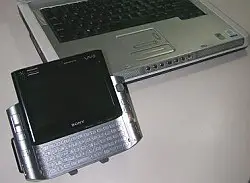Are notebook-style UMPCs just bad laptops?
 That’s the question on the mind of my pal Benz145, moderator extraordinaire of the Micro PC Talk forums.
That’s the question on the mind of my pal Benz145, moderator extraordinaire of the Micro PC Talk forums.
In his recent "UMPC or Crippled Notebook?" article, he stresses that only handtops small enough to change the way you use them are truly deserving of the UMPC moniker. Anything else, he says, is either a sub-notebook or a shrunken slate. He cites the 7"-screened Kohjinsha SH6 in particular and questions the merits of its size over, for example, the 11.1"-screened Sony Vaio TZ notebook. Now technically, a convertible-style tablet PC is much more similar to the SH6 because of its swiveling touchscreen, but his main point is really the trade-off. Since full notebooks and notebook-style UMPCs share the same form factor, their usage scenarios are essentially the same. And if that’s the case, he argues, then not only are the supposed benefits of the SH6’s increased mobility questionable, but the compromises in processing power and other areas don’t make it a worthwhile purchase.
Benz’s main gripe really is the lack of standardization in the UMPC industry and the potential consequences of the term’s misuse, but what intrigues me most is this:
- If a UMPC isn’t small enough to be used differently than its full-sized counterpart, why not buy the fuller-featured and more powerful counterpart instead?
I’ve been thinking about this for longer than I care to admit, and I just can’t make up my mind on whether I agree.
One of the interesting things about the market right now is that UMPCs (or device that are called UMPCs, anyway) come in so many different varieties:
- Mini notebook lookalikes, with or without swiveling displays (e.g., Fujitsu U, FlipStart, NanoBook, and all the Kohjinsha units)
- Handtops with sliding displays (e.g., Sony UX series, OQO Model 02, Amtek U560, and others)
- Tablet-style devices (e.g., Samsung Q1, Asus R2H, and TabletKiosk eo slates)
- PMP-looking oddities (e.g., Raon Digital Vega, Everun, and Wibrain B1)
- MIDs, UMPC Lites, and various handhelds that don’t run a full-blown OS (e.g., Nokia N800, HTC Advantage, and the Windows CE gang)
All of them, even those I don’t quite know how to classify, have screens between about 4 and 7 inches and are therefore quite small in comparison to something like the Sony Vaio TZ. (Don’t ask about the Fujitsu P1610, Flybook V5, or anything else with an 8.9-inch screen!) And all can theoretically be placed on a desk and connected to a keyboard to mimic the typical notebook setup.
But can all of them be used in other ways? (Do they have to be?) Two-handed while standing in line, for example? Slid into a jacket or large pants pocket when not in use? Is this really what makes a UMPC . . . well, a UMPC?
Actually, now that I’ve rambled my way through the jumbled mess inside my brain, the real question actually seems to be whether UMPCs are designed, first and foremost, to lighten your load on the road (so to speak) or to increase your usage scenarios, whatever they may be. After all, someone who wants to get real work done and someone who just wants mobile access to YouTube probably won’t use their UMPCs in the same way.
And I guess that’s the bottom line.
For some, it’s certainly a toss-up. For me, it’s 65% "lighten the load" and 35% "increase usage scenarios."
What’s your breakdown?

